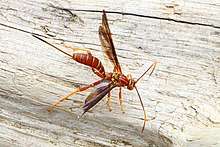Labeninae
The Labeninae is a subfamily within the parasitic wasp family Ichneumonidae (aka Darwin wasps or Ichneumon wasps)[1]. There are 12 extant genera (listed below), grouped within four tribes, that exhibit a predominantly Gondwanan distribution - most genera and species are found in Australia and South America. A few species of Labena and Grotea are found in North America, with hypotheses suggesting that the group radiated on Gondwanaland prior to the separation of Australia but after the separation of Africa/India/Madagascar[2].
| Labeninae | |
|---|---|
 | |
| Labena grallator, Virginia | |
| Scientific classification | |
| Kingdom: | Animalia |
| Phylum: | Arthropoda |
| Class: | Insecta |
| Order: | Hymenoptera |
| Family: | Ichneumonidae |
| Subfamily: | Labeninae Ashmead,1900 |
| Tribes | |
| |
Some species from the tribe Labenini have been reared from wood-boring beetles of the Coleopteran families Buprestidae, Cerambycidae, and Curculionidae[2][3]. Members of the tribe Orthognatheliini (sometimes, incorrectly, called Groteini) parasitize solitary bees; Labium wasps are known to parasitise ground-nesting, solitary bees[4][5], while Grotea are known parasitoids of cavity-nesting, solitary bees[2][6]. Species of Poecilocryptus are thought to be phytophagous, due to adaptations of the larval head capsule. However, as with much of the Ichneumonidae, knowledge of many labenine species' ecology, biology, and evolution is extremely limited or completely lacking.
Genera
These genera belong to the subfamily Labeninae:[7][8]
- Alaothyris Gauld, 1984 c g
- Apechoneura Kriechbaumer, 1890 c g
- Certonotus Kriechbaumer, 1889 c g
- Gauldianus Lanfranco, 2000 c g
- Grotea Cresson, 1864 c g b
- Labena Cresson, 1864 c g b
- Labium Brullé, 1846 c g
- Ozlabium Gauld & Wahl, 2000 c g
- Poecilocryptus Cameron, 1901 c g
- Torquinsha Gauld & Wahl, 2000 c g
- Urancyla Gauld, 1984 c g
- Xenothyris Townes, 1969 c g
Data sources: i = ITIS,[9] c = Catalogue of Life,[10] g = GBIF,[11] b = Bugguide.net[12]
References
- Klopfstein, S. (2019). et al. "Darwin wasps: a new name heralds renewed efforts to unravel the evolutionary history of Ichneumonidae". Entomological Communications. 1: ec01006.
- GAULD, IAN D.; WAHL, DAVID B. (July 2000). "The Labeninae (Hymenoptera: Ichneumonidae): a study in phylogenetic reconstruction and evolutionary biology". Zoological Journal of the Linnean Society. 129 (3): 271–347. doi:10.1111/j.1096-3642.2000.tb00015.x. ISSN 0024-4082.
- Herrera-Flórez, Andrés (2012-08-01). "A new species of Apechoneura Kriechbaumer (Hymenoptera, Ichneumonidae, Labeninae) from Colombia". ZooKeys (213): 41–49. doi:10.3897/zookeys.213.3309. ISSN 1313-2970.
- Batley, Michael; Brandley, Barry (March 2014). "Phenology of the Australian solitary bee species 'Leioproctus plumosus' (Smith) (Hymenoptera: Colletidae)". Australian Entomologist, the. 41 (1): 7.
- Tarlton, Rayment. "A cluster of bees: sixty essays on the life-histories of Australian bees by Tarlton Rayment". Andrew Isles Natural History Books. Retrieved 2019-12-18.
- Flores-Prado, Luis; Niemeyer, H M (2012-05-30). "Host Location by Ichneumonid Parasitoids is Associated with Nest Dimensions of the Host Bee Species". Neotropical Entomology. 41 (4): 283–287. doi:10.1007/s13744-012-0048-6. ISSN 1519-566X. PMID 23950063.
- "Synoptic Lists of World Genera and Family-group Names". American Entomological Institute, Genera Ichneumonorum Nearcticae. Retrieved 2018-05-16.
- Carlson, Robert W. "Superfamily Ichneumonoidea, Discover Life". Retrieved 2018-05-16.
- "ITIS, Integrated Taxonomic Information System". Retrieved 2018-05-16.
- "Catalogue of Life". Retrieved 2018-05-16.
- "GBIF". Retrieved 2018-05-16.
- "Labeninae Subfamily Information". BugGuide.net. Retrieved 2018-05-16.
Further reading
- Townes, H.K. (1969) Genera of Ichneumonidae, Part 1 (Ephialtinae, Tryphoninae, Labiinae (=Labeninae), Adelognathinae, Xoridinae, Agriotypinae). Memoirs of the American Entomological Institute 11: 1-300.